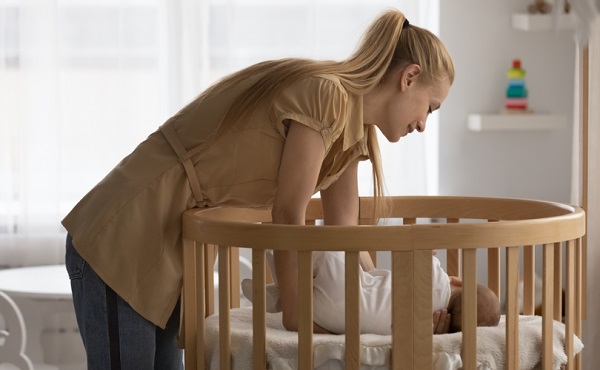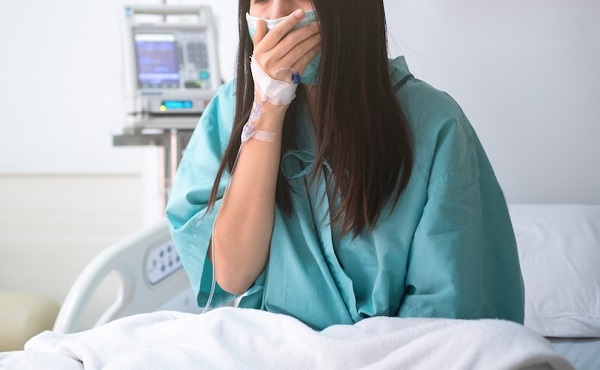Health
Police are charging parents with felonies for not placing infants who died in sleep on their backs

From LifeSiteNews
By Dr. Brenda Baletti, The Defender
Pennsylvania authorities brought felony charges against the parents of two different babies after police said the infants died because the parents placed them in unsafe sleeping positions.
Parents of two different babies are being charged with felonies in Pennsylvania after police say their babies died because the parents placed them in unsafe sleeping positions, SpotlightPA reported.
In both cases, police allege that the parents failed to follow guidance, including handouts given to them at doctor’s visits, stating that babies should be put to sleep on their backs.
Gina and David Strause of Lebanon County are accused of putting their 3-month-old infant son, Gavin, to sleep on his stomach and allowing him to sleep with stuffed animals in the crib.
They are charged with involuntary manslaughter, recklessly endangering another person, and endangering the welfare of children.
Natalee Rasmus of Luzerne County is accused of putting her 1-month-old daughter, Avaya Jade Rasmus-Alberto, to sleep on her stomach on a boppy pillow, often used for nursing. She is charged with third-degree murder, involuntary manslaughter, and endangering the welfare of children.
Rasmus was a 17-year-old mother when her daughter died in 2022. Court records show that she continues to be held at the Luzerne County Correctional Facility with bail set at $25,000 pending resolution of her case.
In both cases, autopsies concluded the babies died of accidental death from asphyxiation. Law enforcement argued in both cases that parents should have known that putting the babies to sleep on their stomachs was unsafe, because they had received paperwork at wellness visits informing them of safe sleeping practices.
They pointed to signed acknowledgements in the babies’ medical records that were created as part of a 2010 state law to educate parents about Sudden Infant Death Syndrome (SIDS).
The law requires hospitals, birthing centers, and medical providers to give parents educational materials from the national Safe to Sleep campaign, and ask them to certify that they received them.
Signing the statement is voluntary. The statement doesn’t indicate that parents can be charged with a criminal offense if they don’t follow the campaign advice.
Advocates from national organizations that educate parents about safe sleep practices found the charges shocking. Nancy Maruyama, the executive director of Sudden Infant Death Services of Illinois, told Spotlight PA, “To charge them criminally is a crime, because they have already suffered the worst loss.”
Alison Jacobson, executive director of First Candle, a non-profit that also educates parents about safe sleep practices, told Pennlive, “There is no law against placing a baby on his or her stomach to sleep. How they can charge this family with involuntary manslaughter is completely baffling to me.”
Researcher Neil Z. Miller, an expert on SIDS and the Safe to Sleep campaign, told The Defender, “Parents of a sleeping baby who dies in the middle of the night should never be charged with murder. That’s just cruel.”
Miller, author of “Vaccines: Are They Really Safe and Effective?” added:
Should parents be obligated to follow every “recommendation” made by their doctor or the Safe to Sleep campaign? Would we as a society prefer that doctors raise our babies instead of the parents? Have other possible causes of death been considered, such as vaccinations? As a society, we can, and must, do much better.
Does placing infants on their backs make a difference?
The handouts shared with new Pennsylvania parents are based on the National Institutes of Health “Safe to Sleep” campaign, which institutionalized a program initiated by the American Academy of Pediatrics (AAP) in 1992 to inform parents to put children to sleep on their backs rather than on their stomachs.
The campaign is based on the premise that babies who sleep on their backs or sides are less likely to die in their sleep. Until that time, it was common for babies to sleep on their stomachs.
The program was launched in the wake of a rising number of SIDS deaths – and growing concern among some parents that the deaths were linked to vaccination.
In a 2021 article in the peer-reviewed journal Toxicology Reports, vaccine researcher Neil Z. Miller provides a history of the SIDS diagnosis, noting that the rise of SIDS coincided with the first mass immunization campaigns.
Between 1992, when the Safe to Sleep program launched, and 2001, SIDS deaths reportedly declined a whopping 55 percent – a number touted in articles celebrating the program, making it appear that babies sleeping on their stomachs was the cause of SIDS, not vaccines.
However, at the same time deaths from SIDS decreased, the rate of mortality from “suffocation in bed,” “suffocation other,” “unknown and unspecified causes,” and “intent unknown” all increased significantly.
Why? The classification system had changed. SIDS deaths were being reclassified by medical certifiers, usually coroners, as one of the other similar categories, not SIDS.
Research published in the journal Pediatrics, the AAP’s flagship journal, concluded that deaths previously certified as SIDS were simply being certified as other non-SIDS causes, such as suffocation – but the deaths were still essentially SIDS deaths.
That change in classification accounted for more than 90 percent of the drop in SIDS rates.
The Pediatrics paper showed no decline in overall postneonatal mortality after the Safe to Sleep campaign was launched, despite the program’s – and the AAP’s – claims to the contrary.
Others verified the Pediatrics paper’s findings, and the trend continued, as reported by multiple studies in top journals. Miller reported that, for example, “From 1999 through 2015, the U.S. SIDS rate declined 35.8% while infant deaths due to accidental suffocation increased 183.8%.”
Research shows that almost 80 percent of SIDS deaths reported to the Vaccine Adverse Event Reporting System (VAERS) happen within seven days of vaccination.
Theories linking vaccines to SIDS suggest that, in some cases, underdeveloped liver enzyme pathways may make it harder for some infants to process toxic ingredients in vaccines. Others argue that other, multiple, complex factors can make some infants vulnerable to toxic ingredients in vaccines.
Baby Gavin was ‘a dream come true’
On April 30, Gina and David Strause were charged with involuntary manslaughter, which carries a sentence of up to 10 years, and other lesser charges in the death of their son, Gavin.
According to the police report, Gina found her son unresponsive, cold, and blue in his crib when she woke up to feed him on the morning of May 8, 2024. She immediately called 911 and performed CPR until the police arrived.
The baby was pronounced dead at the hospital. The autopsy report found the cause of death to be “complications of asphyxia.”
Police said they observed loose items in the crib, “such as blankets and stuffed animals.”
Gina said that after feeding her baby at about 11:30 p.m. the night before he died, she placed him in his crib on his belly, because he was a “belly sleeper,” and covered him with a blanket. She said that she had received the recommendation that he should sleep on his back, but that he preferred to sleep on his stomach.
In an interview with Pennlive, Gina said that she typically put Gavin to sleep on his back, but he had gotten into the daily habit of rolling onto his belly.
Davis Stause told police that when he left for work at 5:30 a.m., he checked on Gavin, who was sleeping on his stomach and moving around a little bit. David said he “patted his butt” to put him back to sleep.
The police reported that they also obtained medical records from birth through death that showed that on the discharge paperwork that the parents received information about safe sleep practices, which included putting the baby on its back, having it sleep in the same room as the parents, and keeping the crib clear of bumper pads and stuffed animals.
They said this paperwork explained how parents could create a safe sleeping environment for their babies to reduce the risk of SIDS.
Baby Gavin also went to the pediatrician for well-child visits on February 7 and 14, March 5, and April 9, a month before he died.
Gina told Pennlive that Gavin, who was born when she was almost 40, was “a dream come true.” She had taken 10 weeks of maternity leave and largely worked at home to spend as much time with him as possible. She said that after she gave birth, she was “overwhelmed” and didn’t remember receiving any paperwork or instructions about sleep.
Gina also said that at the hospital, police treated her and her husband with immediate suspicion, separating and questioning them. They were not allowed to see their baby again before he was taken by the coroner’s office.
The parents created a GoFundMe page, where they shared a copy of the police report, to help cover their legal costs, because they said they do not qualify for a public defender.
The Defender attempted to contact the parents to inquire about the baby’s overall health, if he had any medical conditions, was born prematurely, or had recently received any vaccines, but the parents did not respond by deadline.
The district attorney’s office also did not respond to requests for comment.
‘Tragic accident with no criminal intent to harm or kill the baby’
The forensic pathologist who performed the autopsy for Natalee Rasmus’ baby listed the cause of death as accidental. According to the report, the baby died from asphyxiation, the Times Leader reported.
Rasmus discovered her baby had died on the morning of October 23, 2022, when she picked her up to get her ready for a doctor’s appointment.
Pennsylvania State Police in December charged Rasmus, alleging that she placed her baby face down to sleep against the recommendations of medical personnel and prenatal classes at Geisinger Wyoming Valley Medical Center.
At a preliminary hearing on the case in February, a state trooper testified that Rasmus ignored safe sleeping practices because she had placed her baby face down in her bassinet with a Boppy pillow, which has a tag warning, “Do not use for sleeping.”
The trooper, Caroline Rayeski, also testified that a search of Rasmus’ cell phone found that she had searched the internet to see whether it was ok to allow newborns to sleep on their stomachs. The trooper also seized literature from the prenatal classes stating it is “recommended” to put newborns to sleep on their backs.
“Yeah, she wouldn’t sleep, she’ll just scream, so she has to be like propped up,” Rasmus told the investigating officer, according to Spotlight PA, which reported the story.
Assistant attorneys argued in a preliminary hearing that she disregarded safe sleeping practices, and a judge forwarded the criminal case to county court.
Rasmus is being represented by public defenders Joseph Yeager and Melissa Ann Sulima, who told the Times Leader the baby’s death was “a tragic accident with no criminal intent to harm or kill the baby.”
Yeager said the prenatal literature referring to newborn sleep positions are “recommendations,” not mandates.
“As the death certificate says, it was an accident. Clearly, there was no malice in this accidental death,” said Yeager, who also said the case should be dismissed.
Rasmus’ most serious charge, third-degree murder, is a homicide that involves killing someone without intent to kill, but with reckless disregard for human life. In Pennsylvania, it can carry a prison sentence of up to 40 years.
Court documents indicate that Rasmus remains in jail with a $25,000 bail, pending the outcome of her case. Neither the district attorney nor Rasmus’ attorneys responded to The Defender’s request for comment.
How common is it to bring criminal charges against parents in infant deaths?
Attorney Daniel Nevins told SpotlightPA it is extremely rare for parents to be criminally charged when infants die after sleeping on their stomachs, and that the burden of proof on the prosecutors will be high.
In 2014, Virginia resident Candice Christa Semidey, age 25, was charged with murder after she swaddled her baby and put it to sleep on its stomach, the Washington Post reported. In that case, police similarly did not think that she intended for the baby to die.
She pleaded guilty to involuntary manslaughter and child neglect. She was ordered to serve three years of probation to avoid the five-year prison term she was sentenced to.
Some charges have also been brought against parents in deaths of infants sleeping with Boppy pillows. There have also been several cases of parents charged for sleeping in the same bed as their child.
The Defender recently reported on three SIDS deaths that occurred shortly after vaccination. Police are still investigating the parents of 18-month-old twins who died together a week after receiving three vaccines. Authorities have not yet charged the parents, but initially said they were investigating the deaths as homicides.
Blessings Myrical Jean Simmons, age 6 months, received six routine vaccines at a well-baby visit on January 13. The next morning, her parents found the baby dead in her bassinet. The autopsy lists SIDS as the infant’s cause of death, and no charges were filed against the parents.
This article was originally published by The Defender — Children’s Health Defense’s News & Views Website under Creative Commons license CC BY-NC-ND 4.0. Please consider subscribing to The Defender or donating to Children’s Health Defense.
Addictions
BC premier admits decriminalizing drugs was ‘not the right policy’

From LifeSiteNews
Premier David Eby acknowledged that British Columbia’s liberal policy on hard drugs ‘became was a permissive structure that … resulted in really unhappy consequences.’
The Premier of Canada’s most drug-permissive province admitted that allowing the decriminalization of hard drugs in British Columbia via a federal pilot program was a mistake.
Speaking at a luncheon organized by the Urban Development Institute last week in Vancouver, British Columbia, Premier David Eby said, “I was wrong … it was not the right policy.”
Eby said that allowing hard drug users not to be fined for possession was “not the right policy.
“What it became was a permissive structure that … resulted in really unhappy consequences,” he noted, as captured by Western Standard’s Jarryd Jäger.
LifeSiteNews reported that the British Columbia government decided to stop a so-called “safe supply” free drug program in light of a report revealing many of the hard drugs distributed via pharmacies were resold on the black market.
Last year, the Liberal government was forced to end a three-year drug decriminalizing experiment, the brainchild of former Prime Minister Justin Trudeau’s government, in British Columbia that allowed people to have small amounts of cocaine and other hard drugs. However, public complaints about social disorder went through the roof during the experiment.
This is not the first time that Eby has admitted he was wrong.
Trudeau’s loose drug initiatives were deemed such a disaster in British Columbia that Eby’s government asked Trudeau to re-criminalize narcotic use in public spaces, a request that was granted.
Records show that the Liberal government has spent approximately $820 million from 2017 to 2022 on its Canadian Drugs and Substances Strategy. However, even Canada’s own Department of Health in a 2023 report admitted that the Liberals’ drug program only had “minimal” results.
Official figures show that overdoses went up during the decriminalization trial, with 3,313 deaths over 15 months, compared with 2,843 in the same time frame before drugs were temporarily legalized.
Health
Colorado gave over 500 people assisted suicide drugs solely for eating disorders in 2024

Fr0m LifeSiteNews
The lawsuit says Colorado’s assisted suicide law violates federal protections by allowing physicians to prescribe lethal drugs to some disabled patients under circumstances where others would be directed to mental health care
Doctors in Colorado are pushing assisted suicide on hundreds of patients solely because they suffer from eating disorders, according to a patients’ advocate sharing the harrowing story of one such case.
Writing in the Denver Post, Patient Rights Action Fund and Institute for Patient Rights executive director Matt Vallière tells the story of his friend Jane Allen, who battled anorexia “most of her life,” who in 2018 was diagnosed with “terminal anorexia,” a relatively recent diagnosis which has been criticized as overly broad and dangerous.
Her eating disorder doctor, Jane wrote, “would ‘make an exception’ for me and ‘allow’ me to die, if that was my choice. It didn’t feel like my choice – I felt coerced and spent an incredibly agonizing months in an assisted living facility.” She eventually received the suicide drugs, but was saved by her father winning a guardianship order and having the drugs destroyed.
“I ate just enough to not die right away. And then I ate more,” Jane wrote. “I weaned off the morphine and all the other hospice drugs that kept me in such a fog. I was getting better, and then I was told that I was too much of a liability and dropped from the clinic. I moved from Colorado to Oregon. I have a job that I love, a new puppy, and a great group of friends. I’m able to fuel my body to hike and do the things I love. I’m repairing my relationship with my family, and I have a great therapist who is helping me process all of this. Things obviously aren’t perfect, and I still have hard days. But I also have balance, and flexibility, and a life that is so much more than I was told would ever be possible for me.”
Jane ultimately passed away due to complications from her years of anorexia, which Vallière wonders could have been prevented by not detouring her down the terminal anorexia route. Regardless, her story details how easily similar cases can end in suicide for people without people willing to fight to give them hope. Live Action notes that last year, Colorado saw a record number of people, 510, prescribed suicide drugs solely for dietary disorders.
“What we do know is that these laws are not so rosy as the propaganda would have you believe,” Vallière writes, adding “there has been and will be more collateral damage in people like Jane or Coloradan Mary Gossman, who was told by a nationally renowned Denver eating disorder treatment facility, ‘there’s nothing we can do for you,’ which qualified her for lethal drugs under the law. She’s in a better place now and has joined as a plaintiff in a lawsuit to overturn the law. So, I ask: how many collateral deaths are acceptable to you?”
That lawsuit says that Colorado’s so-called “medical aid-in-dying” or assisted suicide law violates federal protections by allowing physicians to prescribe lethal drugs to some disabled patients under circumstances where others would be directed to mental health care, by “assum[ing] that a request for assisted suicide is not an indication of a mental disorder, when other Colorado laws make precisely the opposite assumption for virtually everyone else.”
Twelve U.S. states plus the District of Columbia allow assisted suicide. In April, however, a bill to legalize euthanasia failed in Maryland.
As Vallière has previously argued elsewhere, current euthanasia programs in the United States constitute discrimination against patients with life-threatening conditions in violation of the Americans with Disabilities Act, as when a state will “will pay for every instance of assisted suicide” but not palliative care, “I don’t call that autonomy, I call that eugenics.”
Live Action’s Bridget Sielicki further notes that “because a paralytic is involved, a person can look peaceful, while they actually drown to death in their own bodily secretions. Experimental assisted suicide drugs have led to the ‘burning of patients’ mouths and throats, causing some to scream in pain.’ Furthermore, a study in the medical journal Anaesthesia found that a third of patients took up to 30 hours to die after ingesting assisted suicide drugs, while four percent took seven days to die.”
Support is available to talk to those struggling with thoughts of ending their lives. The Suicide & Crisis Lifeline can be reached by calling or texting 988.
-

 Censorship Industrial Complex2 days ago
Censorship Industrial Complex2 days agoCanada’s privacy commissioner says he was not consulted on bill to ban dissidents from internet
-

 Business2 days ago
Business2 days agoFormer Trump Advisor Says US Must Stop UN ‘Net Zero’ Climate Tax On American Ships
-

 Alberta2 days ago
Alberta2 days agoEnbridge CEO says ‘there’s a good reason’ for Alberta to champion new oil pipeline
-

 National1 day ago
National1 day agoDemocracy Watch Renews Push for Independent Prosecutor in SNC-Lavalin Case
-

 Business1 day ago
Business1 day agoOver two thirds of Canadians say Ottawa should reduce size of federal bureaucracy
-

 Alberta11 hours ago
Alberta11 hours agoAlberta taxpayers should know how much their municipal governments spend
-

 Indigenous20 hours ago
Indigenous20 hours agoConstitutional lawyer calls for ‘false’ claims to end in Canadian residential schools burials
-

 Alberta11 hours ago
Alberta11 hours agoPremier Smith addresses the most important issue facing Alberta teachers: Classroom Complexity






